 Extension is deservedly considered the most sparing way to restore the dentition. The procedure implies simultaneous restoration of the aesthetics and functionality of the damaged tooth.
Extension is deservedly considered the most sparing way to restore the dentition. The procedure implies simultaneous restoration of the aesthetics and functionality of the damaged tooth.
Ideally, after the completion of manipulation of the dentist, the artificial enamel will be invisible to the eye of others. Obviously, in this case it is a question of paid services of a qualified specialist.
To answer the question about the cost of such a procedure, it is possible only ambiguously, since the price depends on a number of factors, among which:
- the method of carrying out the recovery procedure( the most significant);
- volume of restoration work;
- terms of work;
- required number of visits;
- the cost of the restoration material.
Contents
- Tooth Extension with Composite Material
- How much does it cost to build a tooth with a composite?
- Restoring the dentition with ceramic linings
- Price issue
- Restoring the tooth with the help of crowns
- Cheap and almost not angry
- Restoring the dentition with the
- pins How much should I put?
- How much does it take to build the fangs
Tooth Extension with Composite Material
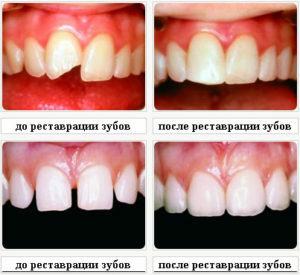
Photo before and after restoration of the teeth with the photopolymer
The easiest method of dentition is photopolymer restoration, which allows to cover the cavity after treatment of caries and restore the crown of the tooth, giving it a natural appearance.
Restorative material in this case is compatible with dental tissues, does not provoke irritation of the mucosa. The composition of polymers contains fluoride, which helps the enamel to recover after serious disturbances.
The main advantage of the procedure is that it is not necessary to remove the root of the tooth, as a result of which the latter remains alive. It should also be noted that time is saved: it is enough to visit the dentist's office only once to restore the dentition.
As a rule, reconstitution with composite material is resorted to if there is a need for minor restoration of the tooth and masking spots on the enamel.
How much does it cost to build a tooth with a composite?
The average cost of building a tooth with the method described is 3000-4000 rubles ( per tooth).
Restoration of a very small chip will cost approximately 1500-2000 rubles .
Restoration of the dentition with ceramic linings
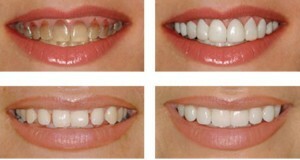
Photo before and after installation of lumineers
Ceramic pads( veneers and lumineers) used to eliminate minor defects on the front teeth will help to create a "Hollywood" smile: small cleavages, interdental spaces, darkening on the enamel.
Veneers are thin but very strong plates that securely attach to the surface of the tooth. The main drawback of this kind of dental procedure is the need to grind the tooth enamel, so often resort to the use of lumineers.
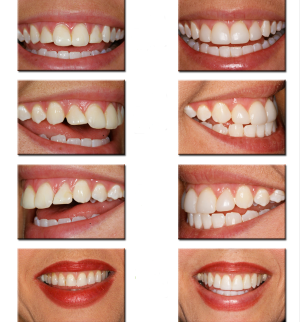
Before and after installation of the
veneers Such designs are presented in the form of ceramic plates, which are so thin that they allow the tooth enamel to be preserved unscathed. In addition, lumineers are much easier to remove.
The cost of augmenting the front teeth with ceramic linings directly depends on the material used. Lumineers and veneers are ceramic and zirconium. The latter option is almost twice as expensive.
In addition, when calculating the cost of the procedure, it should be borne in mind that two front teeth are subjected to the installation of the restoration linings.
This is necessary to eliminate the thickness difference between two adjacent teeth in the area of a smile. Thus, it is possible to install a veneer( lumineer) on a healthy tooth.
Price issue
Approximate price of this type of procedure is 25000-35000 rubles ( one tooth).
Restoring the tooth with the help of the
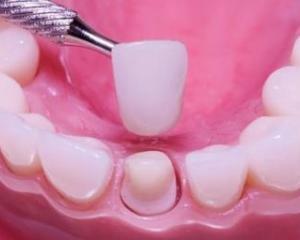 crowns. If the tooth is badly damaged, the patient is offered augmentation with the help of crowns. In the absence of allergies to metals, classical ceramic-metal crowns are used, otherwise only artificial ones - made of zirconium oxide, or ceramic ones - will fit the patient.
crowns. If the tooth is badly damaged, the patient is offered augmentation with the help of crowns. In the absence of allergies to metals, classical ceramic-metal crowns are used, otherwise only artificial ones - made of zirconium oxide, or ceramic ones - will fit the patient.
The entire process of tooth restoration is conditionally divided into two stages. Immediately the doctor prepares the tooth surface, sharpening it and eliminating the affected elements, then removes the impression for the crown.
Cheap and almost not angry
All tooth restoration with ceramic( cermet) crowns will cost from 4500 to 11000 rubles ( per tooth).
The use of artificial crowns will raise the price by 1.5 times.
Restoration of the dentition with the
pins. A pin is called a pin, which is intended to serve as a support for the tooth. The material of the product is titanium or fiberglass.
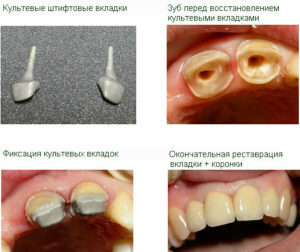 The use of this technology is justified only if the tooth has been fractured by more than 50%.The process includes the following steps:
The use of this technology is justified only if the tooth has been fractured by more than 50%.The process includes the following steps:
- X-ray;
- computer simulation;
- pin installation;
- forming the "tip" of the tooth.
After all the manipulations the tooth remains alive and in most cases it serves for many more years.
How much should you shell out?
When calculating the cost of services in this case, you should focus on the price of building teeth with a filling material.
To this figure it is necessary to add the cost of the pin installation service - from 600 to 3000 rubles ( depending on the version of the product).
How much does it cost to build canines
Today, the number of people wishing to increase their fangs is increasing, the overwhelming majority among them are representatives of the society is ready. Dentists are ready to offer two ways of recreating artificial canines:
-
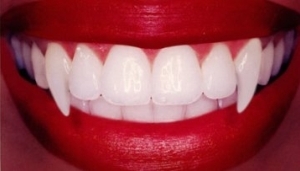 Applying the canine .The process is similar to nail extensions. In this case, light-curing material is applied, which is applied in the required amount to the previously sharpened tooth. This method is considered more gentle by dentists, since the original shape of the tooth can still be returned, although it can not be completely healthy afterwards.
Applying the canine .The process is similar to nail extensions. In this case, light-curing material is applied, which is applied in the required amount to the previously sharpened tooth. This method is considered more gentle by dentists, since the original shape of the tooth can still be returned, although it can not be completely healthy afterwards. - Crown Forming .This technology involves the installation of a crown in the form of a canine. In this case, the tooth can no longer be "worn out" and return its original appearance.
It should be noted that not everyone can grow canines - there are some contraindications, among which the first place is occupied by an incorrect bite of the patient.
The cost of the procedure is 2500-5000 rubles .
Therefore, the cost of services for restoration of the tooth is determined by the dentist at the time of consultation. The specialist individually prepares the work plan, together with the patient chooses the appropriate method, materials, determines the scope and timing of the events.
